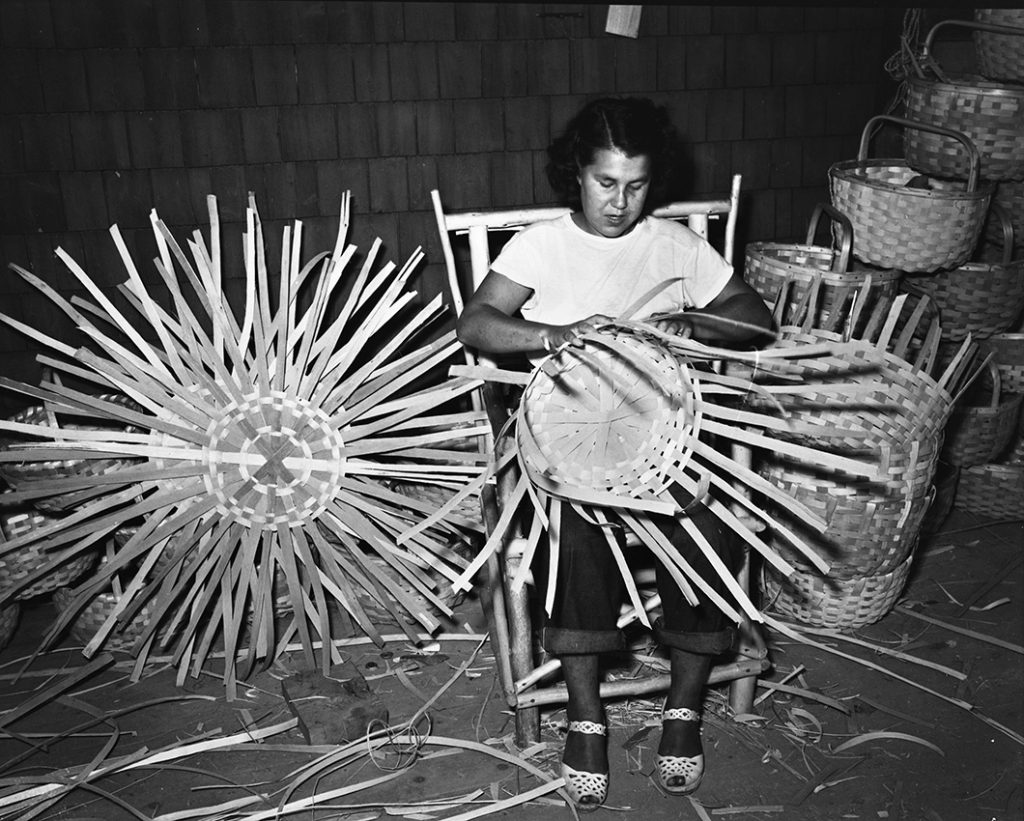“When we imagine history, we imagine a grand structure, a national chronicle, a closely organized and guarded record of agreed-upon events and interpretations, a bundle of “authenticities” and “truths” welded into a flexible conservative narrative that explains how we got from there to here. It is a relationship we have with ourselves, a love affair we celebrate with flags and anthems, …I simply have difficulty with how we choose which stories become the pulse of history and which do not.”
The Inconvenient Indian (P.3), Thomas King
This quote illustrates how there will be different variations of these stories depending on the circumstances of their telling.
Read or tell this story in a Talking Circle for the first time in English only, then in the other language most used in your community.
“How Klu’skap Keluwoskap Created People”
Klu’skap Keluwoskap (Gal-oo-woos-gub) just finished visiting all the wi’sis animals weyossisok to prepare them for the coming of people. There was a risk the wi’sis animals weyossisok might rule over people so Klu’skap Keluwoskap had to reduce their size.
Klu’skap Keluwoskap lived with Wmi’kiju’eml Grandmother Uhkomossol Mulumkwej Groundhog Munimqehs. One day he told her he was lonely, for he needed contact with creatures that looked like him, for he only had relationships with wi’sis animals weyossisok.
Wmi’kiju’eml Grandmother Uhkomossol Mulumkwej Groundhog Munimqehs told Klu’skap Keluwoskap to travel East, where the na’ku’set sekewa’t sun espotewset rises, to the edge of the big samqwan water samaqan, the kta’n ocean supeq. So, Klu’skap Keluwoskap did as he was told, for he deeply respected his Wmi’kiju’eml Grandmother Uhkomossol.
The evening before Klu’skap Keluwoskap created people he gathered dry puksuk wood piwsokul to make a puktew fire sqot. Sitting by the fire he envisioned how this would all come to light. First, he went out to cut a fresh kawatkw tree opos and stripped the bark. Then he carved a bow. He then took sinew and tied one end of the bow and bent it and tied it to the other end. Klu’skap Keluwoskap then whittled an arrow from the same kawatkw tree opos he cut so he would not waste the wood. He then asked the owl if he could use its feathers to put on an end of the arrow, so it would fly swiftly. On the other end, he notched in an arrowhead he chiseled to balance the flight of the arrow.
The first light was approaching from the East, which meant it was time for the creation of people. Klu’skap Keluwoskap then walked to the edge of the eastern land and aimed the arrow straight at a giant wiskoq ash tree wikp. As soon as the sunlight struck the top of the tree, Klu’skap Keluwoskap let the arrow go.
The arrow split the ash tree in half and out emerged the first people of the east with beautiful brown skin and shiny black hair, Waponahkiyik (People of the Dawn).
The creation of Waponahkiyik was beautiful. To this day, Waponahkiyik use the ash tree to create baskets that symbolize the sacredness of life. The weave of the basket represents the unity and building of Waponahki community values. The base of the basket stands for the Kisiku’ki’k Ancestors Kansuhsuwok who hold the teachings and at the top of the basket are the children who will carry our traditions forward.
(Story retold by Ron Tremblay – Story originally told by Joseph Nicholas of Sipayik – Pleasant Point, to Ron Tremblay when Ron was a child and later retold at a gathering at Ron’s home in 2001)
Glossary
| English | Wolostoqey | Mi’kmaq |
|---|---|---|
| Grandmother | Uhkomossol | Wmi’kiju’eml |
| sun | espotewset (ess-ba-dehw-said) | na’ku’set (naw-goo-set) |
| water | samaqan (za-ma-gan) | samqwan (some-go-won) |
| animals | weyossisok (way-us-see-zog) | wi’sis (we-sis) |
| Ancestors | Kansuhsuwok (Gun-zoo-su-og) | Kisiku’ki’k |
| Koluskap | Keluwoskap (Gal-oo-woos-gub) | Klu’skap (glue-scap) |
| fire | sqot (s-gwood) | puktew (book-toe) |
| ocean | supeq (zo-behq) | kta’n (ug-done) |
| tree | opos (a-poz) | kawatkw ( kaw-wat-goo) |
| ash tree | wikp (we-kp) | wiskoq |
The focus of this story is on how Keluwoskap created people although, there is a story usually told beforehand, “How Keluwoskap reduced the size of the Animals”, prior to the creation of people. This story, “How Keluwoskap Created People”, begins with Keluwoskap just getting back from reducing the size of the animals. Otherwise, the animals would have overtaken the lands and waterways and eventually destroyed the newcomers – the people.
- Have students illustrate parts of the story using vibrant colors and then have them try retelling it using either Wolastoqey or Mi’kmaw words by using the glossary at the end of the story. You can download the app to hear the pronunciation on: Mi’kmaw Kina’matnewey or Wolastoqey Latuwewakon
- The circle is a sacred concept in Indigenous cultures as it reflects a cycle or journey just as this story does. There are many cycles found in nature and in life. It is important to make the circle the centre of this first activity. Show the film on the importance of the talking stick and circle in Indigenous cultures https://www.wabanakicollection.com/videos/culture-studies-videos/
- Using a talking stick, have students retell the story as they remember it. They can pass the talking stick freely to the next person when they lose track of the story or if they have nothing more to add.
- Evaluation: Have students retell the portions of the story using the illustrations they created. Listen to teachings of the Eagle Feather and the Sacred Drum in ancestral teachings from the Wolastoqiyik and Mi’kmaq Culture Studies Instructional DVD Package. https://www.wabanakicollection.com/videos/culture-studies-videos/ Try accompanying the story with a drumbeat.
- What do baskets symbolize? Each basket maker had his or her own trademark. Look below. How does the way these baskets are being made reflect the teachings of the elders? How can we continue to look after one another?





